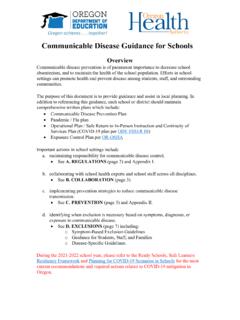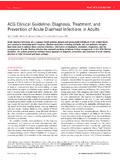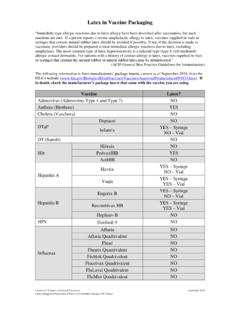Transcription of DRINKING WATER QUALITY - Centers for Disease Control …
1 As development in our modern society increases, there are growing numbers of activities that can contaminate our DRINKING WATER . Improper disposal of chemicals, animal and human wastes, wastes injected underground, and naturally occurring substances have the potential to contaminate DRINKING WATER . DRINKING WATER that is not properly treated or disinfected or that travels through an improperly maintained distribution system may also pose a health safe WATER supply is crucial to public health and plays a critical role in the success of our society and economy. Improvements in WATER QUALITY over the past century in particular, the disinfection of WATER resulted in one of the great public health achievements of the 20th century: a dramatic drop in the incidence of waterborne diseases, such as cholera and typhoid. Before disinfection, the incidence of typhoid fever was approximately 100 cases per 100,000 population in 1900; by 1920, it had decreased to cases per 100,000, and by 1950, to By 2000, there were no typhoid cases related to public DRINKING WATER in the has one of the safest DRINKING WATER supplies in the world.
2 People safely come in contact with WATER every day through DRINKING and eating, bathing, participating in recreational activities, and inhaling WATER vapor or WATER QUALITYQUICK FACTSI mprovements in WATER QUALITY over the past century in particular, the disinfection of WATER result-ed in one of the great public health achievements of the 20th century: a dramatic drop in the incidence of waterborne diseases, such as cholera and eighty-five percent of the American public gets its WATER from a public WATER system, regulated by the Environmental Protection Agency (EPA). Approximately 10% 15% of the population, mostly in rural areas, relies on private, federally unregulated supplies of DRINKING WATER , such as groundwater wells and surface WATER , not subject to EPA standards under the Safe DRINKING WATER ,3In some parts of the United States, arsenic occurs in groundwater at high levels and can present a potential health hazard to people whose primary DRINKING WATER source is private well In addition, some agricul-tural areas have moderate to high risk of nitrate contamination in ground- WATER , which can also cause adverse health WATER QUALITYPICTURE OF AMERICA23 PUBLIC WATER SUPPLIESThe Environmental Protection Agency (EPA) is authorized under the Safe DRINKING WATER Act (SDWA)
3 To protect public health by regulating the nation s DRINKING WATER supplies in about 155,000 public WATER Eighty-five to ninety percent of the American public gets their DRINKING WATER from a public WATER DRINKING WATER SOURCESA pproximately 10% 15% of the population, mostly in rural areas, relies on private, federally unregulated supplies of DRINKING WATER such as groundwater wells and surface WATER not subject to EPA standards under the Safe DRINKING WATER Act or to regular monitoring by other A few state and local governments have regulations to protect users of private wells; but state regulations vary widely, and there is no requirement to report well WATER monitoring data at a national The Geological Survey (USGS) is the nation s primary agency providing information and research on groundwater resources. They operate a national network of observation wells to measure well WATER quantity and QUALITY .
4 Although not a regulatory agency, the USGS collects data about WATER resources, WATER use, surface WATER , ground- WATER , and contaminant movement through these WATERThe Food and Drug Administration (FDA) regulates bottled WATER used for DRINKING . The FDA regulations for bottled WATER generally correspond with EPA standards for chemical or microbial contaminants. However, there are no requirements that bottled WATER QUALITY data be reported to any federal agency or to the , the population is turning to bottled WATER as a primary source of DRINKING WATER . There is no evidence that DRINKING bottled WATER is safer than DRINKING treated WATER from a tap. All DRINKING WATER , including bottled WATER , can be expected to contain small amounts of some contaminants. The QUALITY of bottled WATER depends on the source and how or if the WATER is treated. Information about the source of the WATER and type of treatment is listed on the WATER QUALITY23 DRINKING WATER CONTAMINANTSThe Safe DRINKING WATER Act establishes maximum contaminant levels (MCLs), the highest level of a contaminant that is allowed in DRINKING WATER , for over 80 potentially harmful microorganisms, organic and inorganic chemicals, metals, and radionuclides in DRINKING MCLs for regulated contami-nants are revised as research provides new informa-tion.
5 The EPA also identifies and evaluates unregu-lated contaminants for possible future of DRINKING WATER can occur at the source (in groundwater and surface WATER ) as well as in the distribution system after disinfection has occurred. The sources and causes of WATER contamination include naturally occurring processes, , extreme weather events, naturally occurring contaminants, , arsenic, urbanization, agricultural land use practices, accidental or improper releases of contaminants or waste into WATER bodies, and decaying or damaged WATER that might occur in DRINKING WATER include the following: Escherichia coli, Salmonella, Campylobacter and other bacteria; the protozoan parasites: Cryptosporidium and Giardia lamblii; and enteric viruses, , norovirus and pathogens are typically found in untreated WATER as a result of contamination from human or animal fecal waste and are overwhelmingly responsible for reported Disease outbreaks from DRINKING WATER and recreational AND INORGANIC CHEMICAL CONTAMINANTSC hemical contaminants likely to be found in DRINKING WATER include metals, fertilizers, pesticides and manu-facturing wastes, and Improper disposal of industrial wastes, metals discharged from petroleum refineries, fertilizer runoff, corrosion of household plumbing and discharge from industrial chemical factories are all causes of chemical contamination of DRINKING WATER .
6 DRINKING WATER treatment processes are designed to remove or reduce these contaminants to levels where they may be expected to cause no health added to WATER to Control microbial contamination can also cause health effects if present in great enough concentrations. By-products of those disinfectants can also be responsible for causing adverse health effects and are regulated by the EPA to reduce that may exist in DRINKING WATER from nuclides dissolved in the WATER from natural sources in the earth or occasionally from releases from laboratories or nuclear power plants. A radionuclide is an atom with an unstable nucleus that, to become more stable, emits energy in the form of rays or high speed particles. This is called ionizing radiation. Approxi-mately 80% of our exposure to radioactivity is natural, and another 20% is from man-made sources. We are exposed to naturally occurring radiation from radon gas emitting from rocks and soil and cosmic radiation from space.
7 We also carry small amounts of potas-sium-40 (a radioactive isotope) in our bodies from the foods containing The EPA regulates ionizing radiation in DRINKING WATER QUALITYPICTURE OF AMERICA45 HEALTH EFFECTS OF DRINKING WATER CONTAMINANTST here is a broad range of health effects associated with exposure to DRINKING WATER contaminants. Ingestion or exposure to pathogens at sufficient doses can result in gastrointestinal illness with symptoms, such as diarrhea, nausea, stomach cramps and vomiting. Exposure to higher doses of chemicals, metals or radionuclides can produce biological responses, toxicological effects, and more severe health impacts including cancer, developmental or reproductive effects, neurological effects, and organ ,14 TRACKING DRINKING WATER QUALITYThe best source of DRINKING WATER QUALITY data is compiled by the EPA and the states in the Safe DRINKING WATER Information System (SDWIS). These data are provided through the routine monitoring of community WATER systems required under the Safe DRINKING WATER Act and state- or community-specific DRINKING WATER Federal Safe DRINKING WATER Information System (SDWIS/FED) is a national EPA database system that stores information the EPA uses to monitor about 160,000 public WATER The SDWIS/FED contains basic information about the type of WATER system, the population served, and other system characteristics.
8 The database also contains information about WATER system monitoring requirements and treatment techniques and violations of any regulated State Safe DRINKING WATER Information System (SDWIS/STATE) is a database designed by the EPA to help states run their DRINKING WATER It includes concentrations of regulated contaminants and is more useful than SDWIS/FED for estimating hazards and exposures from DRINKING WATER at a state or local six years the EPA conducts a review of the National Primary DRINKING WATER Regulations and collects complete records of compliance monitoring conducted by The EPA Six-Year Review for 1998 2005 is the largest and most comprehensive DRINKING WATER contaminant occurrence dataset ever compiled and analyzed by the EPA. It contains data from 45 states and 89% of public WATER systems and includes information on 69 Geological Survey (USGS) operates two national programs that collect information on bio-logical and chemical contaminants in DRINKING WATER wells.
9 The USGS National WATER Information System (NWIS) provides access to WATER resources data measuring stream flow, groundwater levels, and WATER QUALITY collected at approximately million sites in all 50 States, the District of Columbia, and Puerto USGS implemented the National WATER - QUALITY Assessment (NAWQA) Program in 1991 to support national, regional, state, and local information needs and decisions related to WATER QUALITY management and During its first decade NAWQA com-pleted assessments in 51 major river basins and aqui-fers across the nation, sampling at nearly 500 stream sites and more than 5,000 wells. Together, the 51 assessments characterized the source of WATER for more than 60% of the nation s DRINKING WATER and WATER for irrigation and industry. Each assessment provided baseline data and information on the occurrence of more than 600 compounds, including pesticides, nutrients, volatile organic compounds (VOCs), trace elements, and radon in WATER , and on the condition of stream habitat and fish, insect, and algal The contaminants most frequently measured at concentrations of potential health concern were inorganic contaminants, includ-ing radon, arsenic and NAWQA continues to address the status of WATER QUALITY by adding monitoring in geographic gaps; investigating new contaminants, such as new pesticides, wastewater compounds, and chemicals in personal care products; and addressing the occurrence of contaminant mixtures and degradation products.
10 Increased emphasis is placed on the QUALITY of source WATER and DRINKING module will focus on three DRINKING WATER contaminants arsenic, nitrates, and disinfection by-products because they have been well studied and occur more frequently than other contami-nants at levels that may be of public health ,22,23,24,25,26,27,28 DRINKING WATER QUALITY45 WHAT IS ARSENIC?Arsenic is a naturally occurring element in certain types of soils and rock formations and can leach into groundwater and surface WATER . In some parts of the United States, arsenic occurs in groundwater at high levels and can present a potential health hazard to people whose primary DRINKING WATER source is private well WATER . Other possible sources of arse-nic contamination in DRINKING WATER include pesticides (insecticides, herbicides and fungicides), leachate from landfills,29 coal ash, wood preservative, feed additives for poultry and swine, cattle and sheep dips used to Control lice and ticks, alloys used in lead acid batteries for automobiles, and semiconductors and light-emitting EFFECTS OF ARSENICA rsenic has been recognized from ancient times as an acute poison.
















